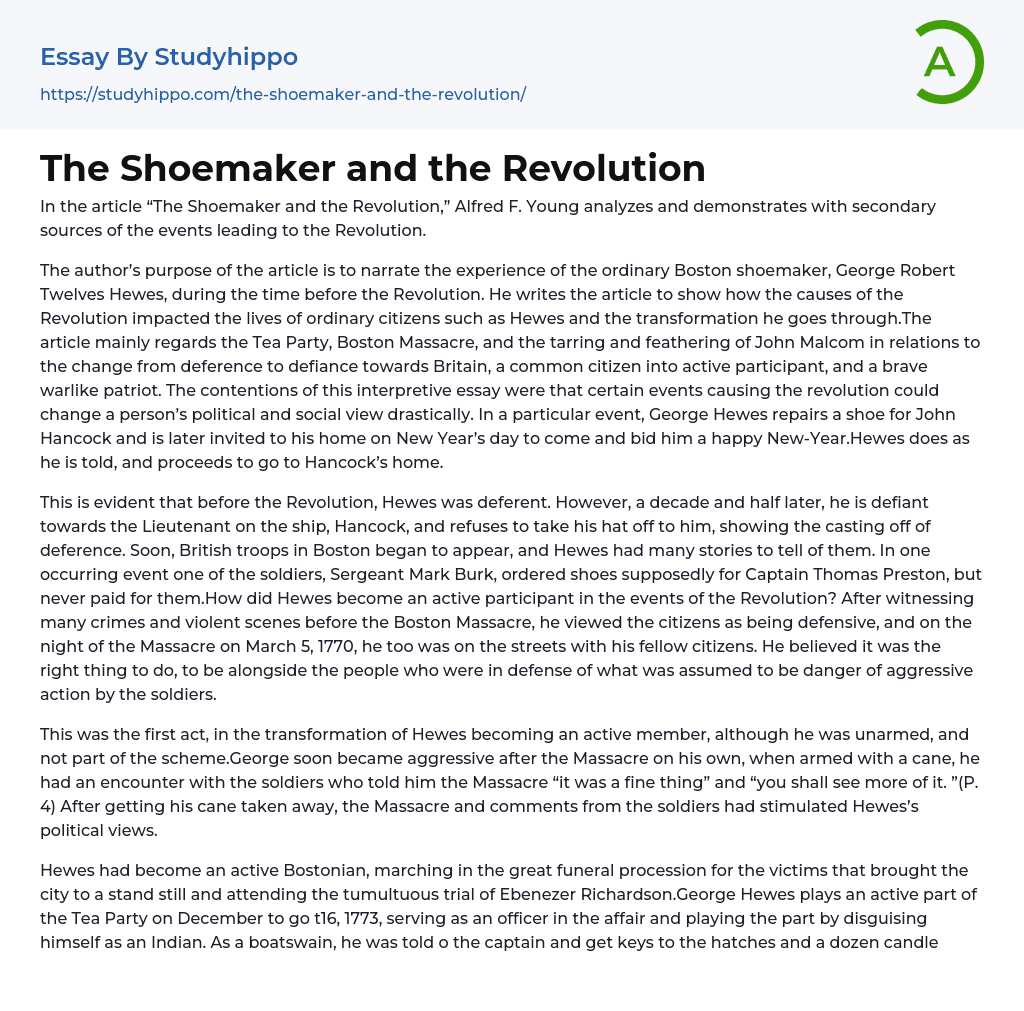In the article “The Shoemaker and the Revolution,” Alfred F. Young analyzes and demonstrates with secondary sources of the events leading to the Revolution.
The author’s purpose of the article is to narrate the experience of the ordinary Boston shoemaker, George Robert Twelves Hewes, during the time before the Revolution. He writes the article to show how the causes of the Revolution impacted the lives of ordinary citizens such as Hewes and the transformation he goes through.The article mainly regards the Tea Party, Boston Massacre, and the tarring and feathering of John Malcom in relations to the change from deference to defiance towards Britain, a common citizen into active participant, and a brave warlike patriot. The contentions of this interpretive essay were that certain events causing the revolution could chang
...e a person’s political and social view drastically. In a particular event, George Hewes repairs a shoe for John Hancock and is later invited to his home on New Year’s day to come and bid him a happy New-Year.Hewes does as he is told, and proceeds to go to Hancock’s home.
This is evident that before the Revolution, Hewes was deferent. However, a decade and half later, he is defiant towards the Lieutenant on the ship, Hancock, and refuses to take his hat off to him, showing the casting off of deference. Soon, British troops in Boston began to appear, and Hewes had many stories to tell of them. In one occurring event one of the soldiers, Sergeant Mark Burk, ordered shoes supposedly for Captain Thomas Preston, but never paid for them.How did Hewes become an active participant in the events of the Revolution? After witnessing
many crimes and violent scenes before the Boston Massacre, he viewed the citizens as being defensive, and on the night of the Massacre on March 5, 1770, he too was on the streets with his fellow citizens. He believed it was the right thing to do, to be alongside the people who were in defense of what was assumed to be danger of aggressive action by the soldiers.
This was the first act, in the transformation of Hewes becoming an active member, although he was unarmed, and not part of the scheme.George soon became aggressive after the Massacre on his own, when armed with a cane, he had an encounter with the soldiers who told him the Massacre “it was a fine thing” and “you shall see more of it. ”(P. 4) After getting his cane taken away, the Massacre and comments from the soldiers had stimulated Hewes’s political views.
Hewes had become an active Bostonian, marching in the great funeral procession for the victims that brought the city to a stand still and attending the tumultuous trial of Ebenezer Richardson.George Hewes plays an active part of the Tea Party on December to go t16, 1773, serving as an officer in the affair and playing the part by disguising himself as an Indian. As a boatswain, he was told o the captain and get keys to the hatches and a dozen candles. After doing as he was told, Hewes and fellow associates began to dump the tea overboard.
It is said that Hewes had worked along with John Hancock on the boat. As the Tea Party ended Hewes was stirred to further action on his
own initiative, just like he had done after the Massacre.
- Media Violence essays
- Domestic Violence essays
- Violence in Video Games essays
- Gun Violence essays
- Video Game Violence essays
- Violence Against Women essays
- Youth Violence essays
- 1920S essays
- 1950S essays
- 1960S essays
- 19Th Century essays
- 20Th Century essays
- Ancient Greece essays
- Bravery essays
- British Empire essays
- Civilization essays
- Colonialism essays
- Declaration of Independence essays
- Evidence essays
- Genocide essays
- Gilded Age essays
- Historical Figures essays
- Historiography essays
- History of the United States essays
- Letter from Birmingham Jail essays
- Louisiana Purchase essays
- Nazi Germany essays
- Rebellion essays
- Revolution essays
- Roman Empire essays
- Russian Empire essays
- The Columbian Exchange essays
- Vikings essays
- War essays
- What is History essays
- World History essays
- World Hunger essays
- Abortion essays
- Abuse essays
- Animal Rights essays
- Animal Testing essays
- Assault essays
- Bullying essays
- Controversial Issue essays
- Crash essays
- Cyber Bullying essays
- Feminism essays
- Human Rights essays
- Immigration essays
- Inequality essays




